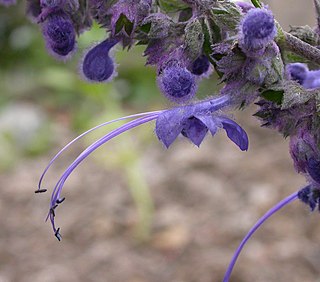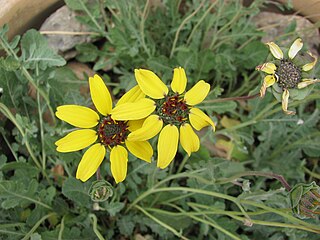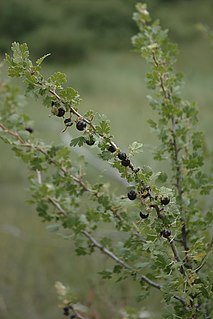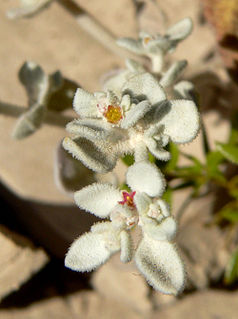
Senecio is a genus of flowering plants in the daisy family (Asteraceae) that includes ragworts and groundsels. The scientific Latin genus name, Senecio, means "old man".

The pecan is a species of hickory native to northern Mexico and the southern United States in the region of the Mississippi River. The tree is cultivated for its seed in the southern United States, primarily in Georgia, New Mexico, and Texas, and in Mexico, which produces nearly half of the world total. The seed is an edible nut used as a snack and in various recipes, such as praline candy and pecan pie. The pecan, in various aspects, is included in state symbols of Alabama, Arkansas, California, Oklahoma, and Texas.

Tagetes is a genus of annual or perennial, mostly herbaceous plants in the sunflower family Asteraceae. They are among several groups of plants known in English as marigolds. The genus Tagetes was described by Carl Linnaeus in 1753.

Coreopsis is a genus of flowering plants in the family Asteraceae. Common names include calliopsis and tickseed, a name shared with various other plants.

Helianthus is a genus comprising about 70 species of annual and perennial flowering plants in the daisy family Asteraceae. Except for three South American species, the species of Helianthus are native to North America and Central America. The common names "sunflower" and "common sunflower" typically refer to the popular annual species Helianthus annuus, whose round flower heads in combination with the ligules look like the sun. This and other species, notably Jerusalem artichoke, are cultivated in temperate regions and some tropical regions as food crops for humans, cattle, and poultry, and as ornamental plants. The species H. annuus typically grows during the summer and into early fall, with the peak growth season being mid-summer.

Ungnadia is a genus of flowering plants in the family Sapindaceae containing one species, Ungnadia speciosa, the Mexican buckeye. It is native to northern Mexico, as well as Texas and southern New Mexico in the United States. The name honours Austrian ambassador Baron David von Ungnad, who brought the horse chestnut to Vienna in 1576, introducing the plant into western Europe.

Justicia is a genus of flowering plants in the family Acanthaceae. It is the largest genus within the family, encompassing around 700 species with hundreds more as yet unresolved. They are native to tropical to warm temperate regions of the Americas, India and Africa. The genus serves as host to many butterfly species, such as Anartia fatima. Common names include water-willow and shrimp plant, the latter from the inflorescences, which resemble a shrimp in some species. The generic name honours Scottish horticulturist James Justice (1698–1763). They are closely related to Pachystachys.

Dichondra is a small genus of flowering plants in the morning glory family, Convolvulaceae. They are prostrate, perennial, herbaceous plants, with creeping stems which take root readily at the leaf nodes. The flowers are white, greenish or yellowish, 2–3 mm diameter. Members of the genus are commonly known as ponysfoots and are native to tropical and cool temperate regions around the world.

Hesperaloe is a genus of flowering plants in the family Asparagaceae, subfamily Agavoideae. It contains perennial yucca-like plants with long, narrow leaves produced in a basal rosette and flowers borne on long panicles or racemes. The species are native to the arid parts of Texas in the United States and Mexico and are sometimes cultivated as xerophytic ornamental plants.

Trichostema is a genus of flowering plants in the family Lamiaceae, which are aromatic herbs or subshrubs. These plants are native to North America. Many plant of this genus which have whorls of small blue flowers are called by the common name bluecurls.

Isocoma commonly called Jimmyweed or goldenweed, is a genus of North American semi-woody shrubs in the sunflower family. It is found in the semi-arid areas of Southwestern United States and Mexico.

Iva is a genus of wind-pollinated plants in the daisy family, described as a genus by Linnaeus in 1753. Plants of this genus are known generally as marsh elders. The genus is native to North America.

Berlandiera is a genus of flowering plants in the aster family, Asteraceae.

Machaeranthera is a genus of North American flowering plants in the daisy family which are known by the common name tansyaster.

Nemastylis, or pleatleaf, is a genus of flowering plants in the family Iridaceae, first described as a genus in 1835. It is native to Mexico, Central America, and the southern part of the United States. The genus name is derived from the Greek words nema, meaning "thread", and stylos, meaning "pillar" or "rod".

Shinnersia is an aquatic plant native to Texas and Mexico. It is classified in tribe Eupatorieae within family Asteraceae.

Tidestromia lanuginosa is a species of flowering plant in the family Amaranthaceae known by the common name woolly tidestromia.

Ribes leptanthum is a spiny-stemmed, small-leaved species of gooseberry in the genus Ribes commonly called trumpet gooseberry. It is native to Arizona, Colorado, New Mexico, Texas, and Utah, where it is usually found in high-altitude canyons.

Tidestromia suffruticosa, the shrubby honeysweet, is a perennial plant in the family Amaranthaceae of the southwestern United States and northeastern Mexican deserts. It has one of the highest rates of photosynthesis ever recorded. It flowers from April to December.
Donovan "Don" Stewart Correll was an American botanist, plant collector, and plant taxonomist, specializing in orchids.



















